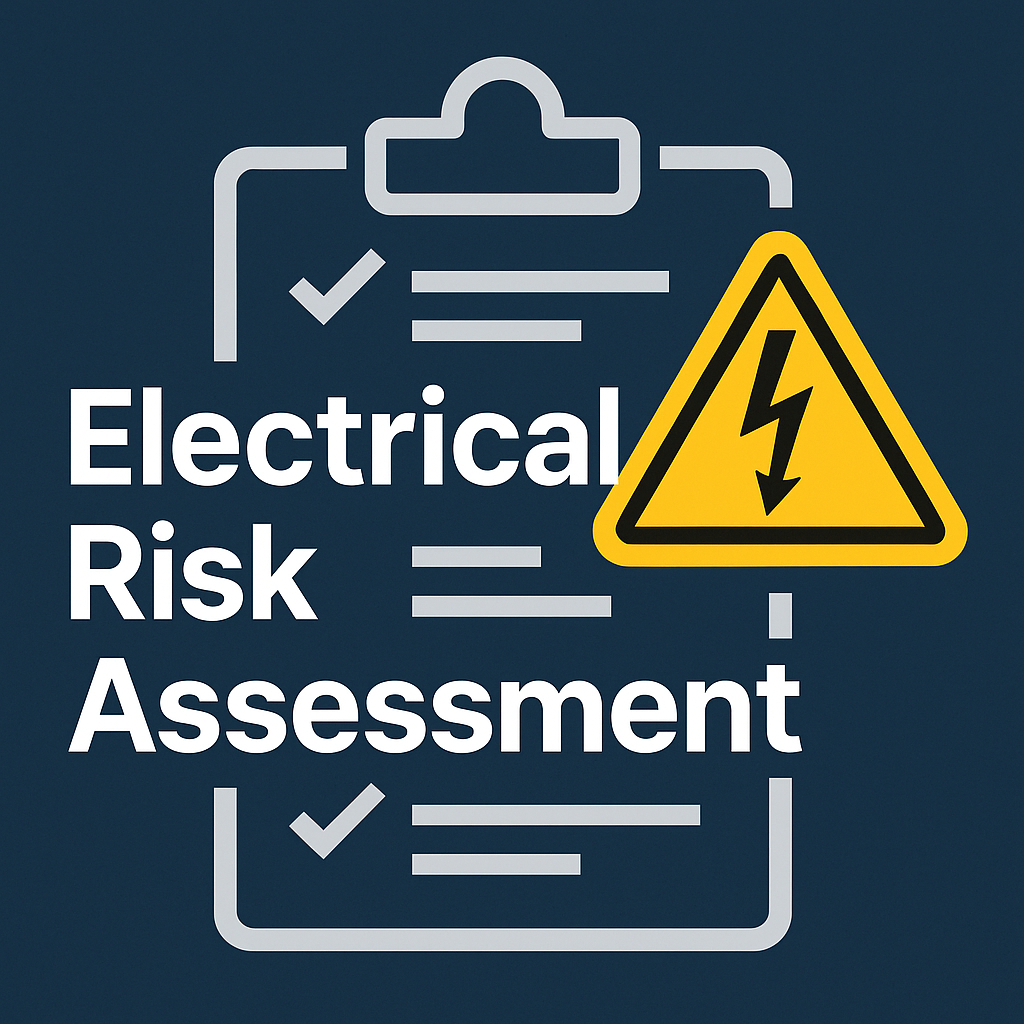
Electrical Risk Assessment
Electricity is invisible — and incredibly dangerous when handled carelessly. Whether it’s a simple repair or complex system testing, electrical risks are everywhere: shocks, arc flashes, fires, and even explosions.
An electrical risk assessment is the process of identifying electrical hazards, evaluating their risks, and applying controls to eliminate or minimize danger. It’s like turning on the lights before walking into a dark room — you don’t want surprises where voltage is involved.
Laws and Standards for Electrical Safety
OSHA Standards (29 CFR 1910 Subpart S)
This regulation outlines how employers must protect employees working with or around electrical systems, including lockout/tagout and safe installation standards.
NFPA 70E: Electrical Safety in the Workplace
This U.S. standard focuses on arc flash risk, PPE requirements, hazard labeling, and training — a must-have for any electrical safety program.
IEC and Indian Standards (IS 5216)
IEC 60364 and India’s IS 5216 define safety procedures for electrical installations, shock prevention, and equipment maintenance protocols.
Common Electrical Tasks at Risk
Equipment Maintenance and Repairs
Electrical panels and switchboards can carry high voltage — one mistake and the results can be fatal.
Installation of Wiring and Panels
Cutting wires, connecting terminals, or working inside energized panels poses high electrocution risk.
Live Electrical Testing
Voltage checks, continuity tests, and commissioning work can expose workers to live circuits.
Use of Portable Electrical Equipment
Damaged cables, missing grounding pins, or wet conditions add danger to even basic tools.
Common Electrical Hazards
Electric Shock and Electrocution
Direct contact with live conductors or faulty tools can lead to heart failure or death.
Arc Flash and Arc Blast
A sudden release of energy from a short circuit can cause severe burns, blindness, or death.
Electrical Fires
Overloads, short circuits, or defective wiring can trigger devastating fires.
Faulty or Damaged Equipment
Old, frayed, or tampered electrical gear is a ticking time bomb.
Overloaded Circuits
Plugging too many devices into a single outlet can overheat wires and start a fire.
When to Conduct an Electrical Risk Assessment
Before Any Electrical Maintenance
Even a minor task like replacing a socket requires assessing the associated risks.
During New Installations
A full risk evaluation ensures that cables, panels, and protective devices are safe and compliant.
After an Electrical Incident
Whether it’s a spark, shock, or fire, every incident must trigger a reassessment.
Periodically for Compliance
Schedule routine assessments, especially in high-risk areas like factories, labs, or data centers.
Key Elements of an Electrical Risk Assessment
Step 1 – Identify Hazards
Look for exposed wires, improper grounding, missing covers, or overloaded circuits.
Step 2 – Identify People at Risk
Anyone near electrical systems — technicians, machine operators, maintenance staff, or cleaning crew.
Step 3 – Evaluate Risks and Decide Precautions
What’s the severity and likelihood of harm? What controls can reduce the risk?
Step 4 – Record Findings and Actions
Use a standardized form to document hazards, controls, and who’s responsible.
Step 5 – Monitor and Review
Check regularly — especially after equipment upgrades or changes in operations.
Electrical Risk Control Measures
Lockout/Tagout (LOTO) Procedures
De-energize and isolate circuits before work begins. Tag the system and lock it to prevent accidental re-energization.
Insulation and Grounding
Use proper insulation for wires and ensure all metal parts are grounded to avoid shock.
Circuit Breakers and RCDs
Install Residual Current Devices (RCDs) to cut off power during a fault — saving lives.
Signage and Restricted Access
Clearly label high-voltage areas and restrict entry to authorized personnel only.
Use of Non-Conductive Tools
Fiberglass or plastic-handled tools help prevent electrical conduction.
Hierarchy of Controls for Electrical Hazards
Eliminate – De-energize Systems
Whenever possible, shut off power before starting any task.
Substitute – Use Low Voltage Systems
Replace high-voltage systems with safer, low-voltage alternatives when feasible.
Engineering Controls – Barriers, Insulation
Install protective covers, barriers, and panels to isolate live parts.
Administrative Controls – Procedures, Training
Implement safe work procedures, conduct audits, and train staff on electrical hazards.
PPE – Rubber Gloves, Arc Flash Suits
Provide appropriate PPE, especially when working near energized equipment.
Electrical Safety Tips
Never Work on Live Circuits
Unless absolutely necessary and authorized under permit conditions.
Use Proper Tools and Equipment
Only use insulated, voltage-rated tools and calibrated testing devices.
Always Wear Appropriate PPE
For arc flash zones, this includes a full suit, gloves, and face shield.
Electrical Risk Assessment Template
Format and Fields to Include
- Job description
- Electrical hazards identified
- Risk rating (before and after control)
- Required control measures
- PPE needed
- Person responsible
- Lockout/tagout steps
- Review and sign-off sections
How to Use It On-Site
Complete before starting work. Use during toolbox talks. Keep updated copies available with the safety officer.
Electrical Work – Risk Assessment
General Information
- Project/Site Name: Sunrise Residency – Tower 2
- Assessment Title: Risk Assessment for Electrical Installation and Maintenance
- Location: Basement Transformer Room & Residential Floors
- Assessed By: Mahendra Lanjewar (Safety Officer)
- Assessment Date: 01 July 2025
- Review Date: 01 October 2025
- Activity Description: Electrical wiring, panel connection, transformer maintenance, and power distribution installation during construction phase.
Electrical Risk Assessment Table
| Task | Hazards Identified | Persons at Risk | Risk Rating (Before Control) | Control Measures | Risk Rating (After Control) | Responsible Person |
|---|---|---|---|---|---|---|
| 1. Electrical panel installation | Electric shock, arc flash | Electricians, helpers | High | – Isolate power source before work – Use insulated tools and PPE – Verify with voltage detector – Lockout/Tagout procedures | Low | Electrical Supervisor / Safety Officer |
| 2. Cable pulling and termination | Trip hazard, electrocution from live wires | Workers, passersby | Medium | – Ensure cables are de-energized – Cover exposed ends – Use signage and cable trays – Secure cables to prevent tripping | Low | Site Engineer |
| 3. Working near live circuits | Burns, shock, explosion | Electricians, nearby workers | High | – Do not work live unless authorized – Use arc-rated PPE (gloves, face shield) – Keep unauthorized personnel away – Post warning signs | Medium | Electrical Engineer |
| 4. Temporary power supply and generators | Electric shock, overloading, fire risk | All site workers | High | – Install ELCB/RCDs – Use weatherproof distribution boxes – Regular inspection of generator and cables – Grounding of generator and panels | Low | Generator Operator / Safety Officer |
| 5. Use of hand tools (drills, cutters) | Short circuit, sparks, cuts | Electricians | Medium | – Use double-insulated tools – Inspect before use – Avoid wet conditions – Provide training on tool handling | Low | Electrical Foreman |
| 6. Inadequate earthing or bonding | Risk of electrocution or fire | Electricians, occupants | High | – Test earthing before energizing system – Ensure all panels and fixtures are bonded – Use certified materials – Keep records of test results | Low | Quality Inspector |
| 7. Poor housekeeping during electrical work | Slips, fire from wire clutters | All workers | Medium | – Organize materials – Clean area after work – Keep wires coiled or secured – Provide bins for cable insulation waste | Low | Supervisor |
Risk Rating Matrix
| Severity | Likelihood | Risk Rating |
|---|---|---|
| 1 – Minor injury | 1 – Unlikely | Low |
| 2 – Lost time injury | 2 – Possible | Medium |
| 3 – Major/fatal injury | 3 – Likely | High |
Note: Risk Rating = Severity × Likelihood
Additional Notes
- Permit to Work: Electrical Permit to Work is mandatory for high-voltage tasks.
- Training Required: Only certified and licensed electricians are allowed to handle panel or transformer work.
- Tools Required: Voltage tester, insulated hand tools, lockout/tagout devices, arc flash suit (for high-risk jobs).
- PPE Required: Safety helmet, rubber gloves, arc-rated overalls, face shield, safety boots.
- Signage: “Danger – High Voltage,” “Authorized Personnel Only,” and Lockout Tags must be displayed at panel rooms and work zones.
Emergency Preparedness
- First Aid Box: Available near transformer room and electrical store.
- Emergency Contact: Displayed at all electrical rooms.
- Rescue Rod and Insulating Mat: Placed in transformer rooms and HV switch rooms.
- Fire Extinguishers: CO₂ and Dry Chemical Powder (DCP) extinguishers available and accessible.
Review and Sign-Off
| Name | Designation | Signature | Date |
|---|---|---|---|
| Rupesh Wasnik | Safety Officer | [Signature] | 01-07-2025 |
| Aakash Sharma | Project Electrical Engineer | [Signature] | 01-07-2025 |
| Vinay Joshi | Project Manager | [Signature] | 01-07-2025 |
Conclusion
Electricity is powerful, useful — and deadly when taken for granted. An electrical risk assessment isn’t red tape — it’s your life insurance. Whether you’re tightening a terminal or testing a high-voltage panel, stop and ask: “Have I assessed the risks?” Because when it comes to electricity, a little planning goes a long way — and a little neglect can cost everything.
Scaffolding Work Risk Assessment
Work at Height Risk Assessment
4 Steps of Job Safety Analysis (JSA)
FAQs
1. What is the most common electrical hazard?
Electric shock is the most frequent and deadly hazard in electrical work.
2. How often should electrical risk assessments be carried out?
Regularly — and before any electrical task, or after an incident or system modification.
3. Who can carry out an electrical risk assessment?
Only a qualified and competent person with knowledge of electrical systems and workplace hazards.
4. What is the importance of Lockout/Tagout?
LOTO ensures equipment is de-energized and cannot be turned on accidentally — preventing shocks and fatalities.
5. Is PPE mandatory for all electrical work?
Yes. PPE like gloves, arc flash suits, and safety shoes is essential, especially when working on or near live systems.
























